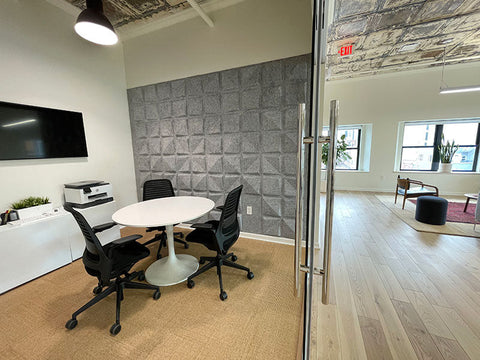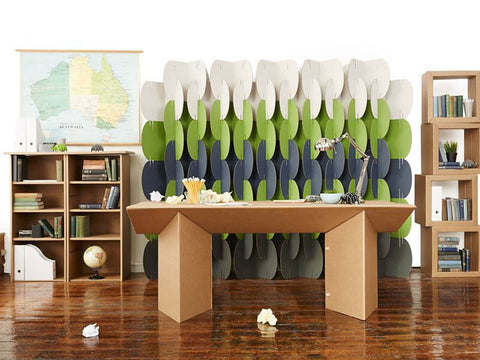In today’s echo-prone interiors—from open-plan offices to urban apartments—sound isn’t just something we hear. It shapes how we feel, how we focus, and how we connect. Enter sound absorbing wall panels: quiet problem-solvers that double as design statements.
At MIO, we believe beautiful, sustainable acoustics start with understanding how sound works—and how spaces should feel. Let’s start there.
[products ids="deco-feltforms-acoustic-tiles, quiltforms-acoustic-wall-art-27-quarter-circle"]
What Is NRC—and Why Should You Care?
Sound travels in waves. When it hits a surface, one of three things happens: it's reflected, absorbed, or diffused. Hard surfaces like glass, concrete, and drywall reflect most of that energy, creating echoes and amplifying noise. Soft, porous materials—like felt—can absorb those waves and convert them into small amounts of heat, effectively quieting the room.
This is where NRC, or Noise Reduction Coefficient, comes into play. NRC is a standardized measurement that tells us how well a material absorbs sound on a scale from 0 to 1 critical for recording studio treatment and offices. A rating of 0 means no sound is absorbed (everything is reflected), while a rating of 1 means nearly all sound is absorbed. Most everyday environments filled with hard surfaces fall well below ideal acoustic conditions, making them noisy and fatiguing.
Our Feltforms acoustic panels, made from recycled PET, are engineered to improve sound quality across a range of applications. Depending on the design and thickness, their NRC ratings range from 0.15 to 0.45. That means you can fine-tune how much sound you absorb—creating a space that’s more comfortable, focused, and aesthetically refined. That means you can dial in the right amount of acoustic comfort—without compromising aesthetics.
 |
 |
From Bedrooms to Boardrooms: Where Sound Absorbing Wall Panels Make an Impact
At Home: Better Sound Where You Live
Bedrooms – Reduce Noise, Improve Rest
Your bedroom should be a peaceful space, not a source of unwanted noise. Hard surfaces can amplify echoes and let outside sounds in. Installing acoustic panels behind the bed or on window-facing walls can help absorb that noise, making it easier to sleep, relax, or focus on quiet activities.
Living & Dining Rooms – Manage Echo and Elevate Atmosphere
Large windows, open layouts, and smooth materials like hardwood floors and tile make living and dining rooms especially prone to echo. To reduce reverberation, install acoustic panels on the largest wall surfaces—such as behind a sofa, along a dining room wall, or on the ceiling if the space has high volume. This helps soften conversation, quiet clinking dishes, and maintain a warm, welcoming environment without compromising on design.
Children’s Playrooms – Colorful Calm
Kids bring joy—and volume. Sound-absorbing felt panels balance high-energy play with a more comfortable environment. Bright, customizable patterns double as wall art and help reduce noise from bouncing balls, footsteps, and cheerful shrieks.
Media & Listening Rooms – Tune into the Moment
To create a balanced sound environment for music, film, or podcasts, proper acoustic treatment is essential. Installing panels on side and rear walls helps reduce echo and prevents sound from bouncing unevenly around the room. This not only improves clarity in dialogue and vocals but also tightens bass response—the way low-frequency sounds behave. Without treatment, bass can sound boomy or overwhelming due to corner reflections and standing waves. Feltforms smooths out those irregularities, making bass sound more controlled and immersive. With thoughtful placement, you can transform a simple room into a refined listening space that’s enjoyable and accurate.

At Work: Focus, Flexibility, and Function
Open Offices – Create Acoustic Zones Without Building Walls
Open offices encourage collaboration, but they’re often filled with competing sounds—keyboard clicks, side conversations, and HVAC hum. Feltforms panels can be used to define acoustic zones by placing them behind desks, on partition walls, or around shared tables. This setup helps absorb sound energy at its source and prevents it from traveling across the room. The result is a more focused environment with less distraction—without isolating your team.
Conference Rooms – Ensure Every Voice Is Heard
In conference rooms, sound clarity is essential for productive meetings. Hard walls and glass surfaces reflect sound, causing flutter echoes and muddled speech. Installing Feltforms panels on the walls behind the main speaker and on opposing walls or ceilings can reduce these reflections. This improves intelligibility and comfort for in-person and remote participants, ensuring conversations are captured clearly and presentations are easy to follow.
Reception Areas – Make a Quiet, Lasting Impression
Reception areas are the front door to your brand—and often some of the noisiest spaces in an office. Feltforms panels reduce common noise sources like foot traffic, phone calls, and HVAC rumble by absorbing sound that would otherwise bounce across hard floors and walls. Mount panels behind reception desks, near seating areas, or along hallways to create a warm, welcoming experience that feels as thoughtful as it looks.
Creative, Commercial, and Community Spaces
Studios & Stages – Designed for Clean Audio
In recording studios, rehearsal spaces, and podcasting rooms, clean sound capture is everything. Reflections off bare walls or ceilings can cause phase issues, comb filtering, or muddy mixes. Feltforms panels installed behind microphones, mixing stations, or rehearsal zones help absorb mid- and high-frequency reflections, creating a more controlled acoustic field. Whether you’re designing a small home studio or a black box performance space, these panels help deliver consistent, intelligible sound—without the sterile look of traditional foam tiles. Ideal for anyone searching for decorative acoustic panels for recording studios or "acoustic treatment for home podcast setups."
Retail & Restaurants – Quiet the Chaos
Cafés, boutiques, restaurants, and hotel lobbies all share a common challenge: beautiful finishes often create unwanted noise. High ceilings, glass storefronts, and tile floors bounce sound, making conversations difficult and creating an uncomfortable din. Feltforms panels can be mounted on focal walls, soffits, or between light fixtures to absorb noise where it builds up. That means clearer conversations, a more pleasant atmosphere, and a design that feels as thoughtful as your brand. Ideal for anyone looking for restaurant acoustic panels or stylish sound absorbing tiles for retail spaces.
Churches & Event Venues – Control Echo in Large Spaces
Sanctuaries, fellowship halls, and event venues often struggle with long reverberation times that make speech unintelligible and music lose clarity. Feltforms panels can be installed on the rear walls, ceilings, or balcony faces to absorb excess reverberation while blending with architectural features. This improves the listening experience for both spoken word and live performance. These panels are ideal for use in church soundproofing solutions or acoustic wall treatments for community centers.

Smart Placement = Better Performance
Strategic positioning is key to effective sound control. Even the highest-rated acoustic panels will underperform if not placed correctly. Here's how to position Feltforms panels to get the best acoustic return while complementing your space.
Living Rooms – Place panels behind sofas, TVs, or on large blank walls to absorb reflections from hardwood floors, windows, and ceilings. This reduces echo and makes conversations more comfortable.
Bedrooms – Mount panels above headboards or on walls that face busy streets or neighboring rooms. This helps block exterior noise and reduces nighttime disturbances.
Workspaces – For home offices or open-plan desks, position panels behind monitors, along side walls, or above workstations to minimize sound reflections and create a focused, quiet zone.
Conference Rooms – Panels placed behind the main speaker, opposite walls, and on ceilings help absorb flutter echoes and prevent sound from bouncing back and forth. This improves speech clarity and overall communication.
Open Plans – Use acoustic tiles to break up expansive, reflective surfaces. Stagger panels along walls, between desks, or on freestanding dividers to create distinct sound zones without building walls.
Pro Tip: With high-NRC panels like Feltforms, coverage doesn’t need to be total. A few strategically placed panels can dramatically improve sound quality while enhancing your space visually.
Pro Tip: High-NRC panels like Feltforms mean you don’t need to cover every wall. A few well-placed tiles go a long way.

Panels That Pull Double Duty: Design + Acoustics
The days of generic, poorly designed, toxic, or less sustainable acoustic materials are over. Modern acoustic wall panels now offer a complete package: sound absorption, visual impact, and sustainable material innovation. Feltforms takes this further by combining architectural aesthetics with performance-driven design—all while putting environmental responsibility at the core.
Feltforms reimagine acoustic treatment as part of the built environment, not an afterthought. Because they’re made from recycled PET felt, Feltforms tiles not only enhance visual appeal and acoustic performance—they also reduce waste, support circular design practices, and can contribute to LEED certification in sustainable building projects.
Style – Choose modern neutrals or bold hues to match your palette. Our color options integrate seamlessly with both residential and commercial interiors.
Texture – Add tactile warmth and visual depth with dimensional felt that invites both touch and attention.
Modularity – Mix and match tile patterns to create large-scale feature walls or subtle, sound-absorbing accents. Modular designs make it easy to adapt to any room layout.
Sustainability – Crafted from recycled plastic bottles and produced locally, Feltforms acoustic panels are a smart choice for sustainable architecture, eco-conscious renovations, and green-certified building projects.
Whether installed as an understated backdrop or an expressive focal point, Feltforms turn any surface into a sound-conscious canvas—offering decorative acoustics that enhance well-being, clarity, and design integrity.
Understanding Feltforms: Choose the Right Tile for Your Space
Feltforms tiles come in four distinct styles, each designed with specific sound absorption goals in mind. Whether you need to reduce echo in a conference room or add subtle acoustic support to a retail space, there’s a pattern to fit.
Quad: Balanced Absorption for Active Environments
NRC: 0.45
Quad modular wall tiles provide solid sound absorption and some diffusion, making them ideal for rooms with mixed activity. Great for echo control without over-dampening. Use in: offices, conference rooms, lobbies, libraries, and home theaters.
Deco: Clear Sound for Communication Zones
NRC: 0.40
Deco tiles reduce mid- and high-frequency noise, which helps sharpen speech. Perfect for areas where clarity and focus matter. Use in: phone booths, hallways, reception areas, dining nooks, and classrooms.
Twist: Light Absorption with Maximum Style
NRC: 0.15
Twist tiles are best for adding visual interest and gentle sound control. They work well in large decorative installs. Use in: lounges, showrooms, restaurants, home offices, and creative studios.
Edge: Clean Finishing with Functional Support
NRC: 0.15
Edge tiles frame other Feltforms installations or serve as lightweight sound absorbers on their own. Use in: tile borders, ceilings, pop-up displays, retail spaces, and wall layering systems.
Why Choose Feltforms? The MIO Culture Difference
Recycled PET – Made from post-consumer plastic bottles.
Made in the USA – Designed and produced locally.
Flexible NRC Options – Ranging from 0.15 to 0.45.
Modular + Magnetic – Easy to install, reposition, and evolve over time.
Feltforms isn’t just a product. It’s a toolkit—a sustainable acoustic system built for creativity, wellness, and change.
Sound Is a Feeling—Design Accordingly
At MIO, we know that a good-sounding space is a better-feeling one. Whether you're reducing stress in a classroom, improving productivity in a home office, or turning a noisy corner into a cozy nook, Feltforms helps you do it with elegance and intention.
Create spaces that sound as good as they look. With Feltforms, acoustics becomes art.
FAQS
Can Decorative Panels Truly Improve Speech Clarity?
Yes, decorative acoustic panels can significantly enhance speech clarity when properly selected. Panels with an NRC of 0.4 or higher (like Feltforms Deco or Quad tiles) specifically target mid-to-high frequency ranges where human speech occurs. In practical applications, they reduce disruptive flutter echoes in conference rooms and improve word recognition scores in classrooms and open offices.
What's the Ideal NRC for Home Studios?
For home studios, the optimal NRC range is 0.4-0.6. This specification provides balanced absorption across frequencies: panels in this range effectively control mid/high frequencies (2000-5000 Hz) where vocal clarity and instrument definition live, while thicker bass traps (4-6") handle low-end buildup. According to audio engineering standards, this combination reduces comb filtering during recording and prevents over-dampening that can make mixes translate poorly.
Can You Achieve Professional Acoustics Without Permanent Installation?
Yes! Freestanding acoustic panels and modular divider systems now deliver professional sound control without permanent installation. Options like weighted felt panels (NRC 0.4+) or mobile sound barriers provide studio-quality noise reduction - simply place them between noise sources and listening areas. These solutions preserve walls while offering flexibility to reconfigure spaces as needed.





